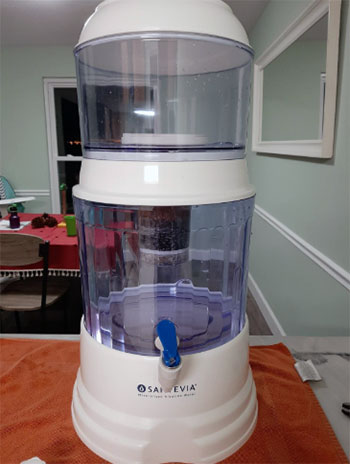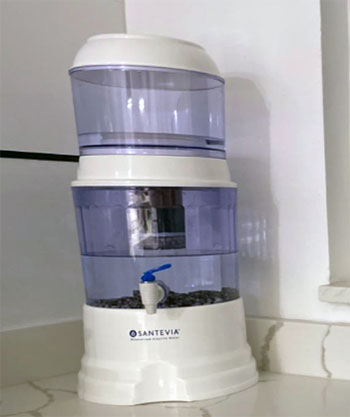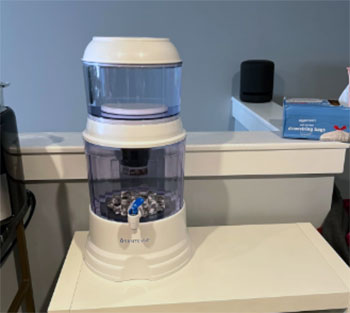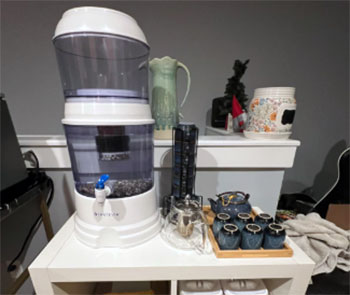You are likely reading this because you’re on the hunt for a better way to hydrate, something beyond basic tap water or endlessly buying plastic bottles. If you’re considering an investment in a water filtration system that does more than just remove chlorine, you need to know about Santevia.
This article isn’t just a dry rundown of specs; it’s a genuine, first-person review to help you understand if the Santevia system is the right fit for your home and health goals. From my own exhaustive research and daily use, I’m going to walk you through the entire experience, from the initial setup to the long-term benefits. By the time you finish reading, you will have a clear, analytical picture of its performance, maintenance, and how it stacks up against the competition.
The Santevia water filtration system, especially their Gravity Water System, is something I would immediately recommend looking into if you are seeking a comprehensive, gravity-fed filter that not only cleans your water but also mineralizes and alkalizes it. You should buy this product directly from the Santevia official website or a trusted, authorized retailer to ensure you receive a genuine unit and qualify for any warranty or customer support.
My Experience With Santevia Water Filtration System
I remember the day I decided I’d had enough with my old pitcher filter. It was small, required constant refilling, and honestly, the water still tasted… flat. I was drinking filtered water, but I wasn’t enjoying it, and I knew I wanted more than just chlorine removal. I started looking for a system that could genuinely replicate the clean, crisp taste of mountain spring water, and that’s how I stumbled upon the concept of alkaline, mineralized water filtration. The Santevia Gravity Water System kept popping up in my research, touting a multi-stage process that filters, mineralizes, and alkalizes. It sounded too good to be true, but the promise of improved hydration and a system that didn’t require plumbing or electricity was incredibly appealing.

When the large box arrived, I felt a mix of excitement and apprehension. Assembling any new kitchen appliance can be a pain, but I was pleasantly surprised.
The Gravity System is a countertop unit, and while it’s substantial in size, the components were straightforward.
It took me about 30 minutes to get everything set up, and that included the all-important process of priming the filters.
Priming is absolutely crucial—it’s what prepares the filters to allow water to flow through correctly, and you must follow the instructions exactly, conditioning both the ceramic pre-filter and the main filter.
It’s a small but necessary bit of effort that pays off in filter lifespan and performance.
The first few tanks of water, as instructed, I discarded—or, rather, I used them to water my thirsty houseplants.
This pre-run allows the system to flush out any manufacturing residue or fine particles from the new filters. Then came the moment of truth: the first glass. I filled a glass directly from the tap, and then one from the Santevia dispenser. The difference was night and day.
The tap water, even with a previous cheap filter, had that characteristic chemical tang—you know the one, faintly metallic and slightly chlorinated. The Santevia water, however, was noticeably smoother. It felt “wetter,” if that makes sense. It was crisp, clean, and lacked any of the harsh tastes or smells of my municipal water. My husband, who is typically skeptical of my health-related purchases, took a sip and actually paused, saying, “Wow, that’s really good.” That sealed the deal for me; it wasn’t just my imagination.
Using the system quickly became a part of my daily rhythm. I would pour water into the top tank in the evening, and by morning, the lower tank would be full of ready-to-drink, mineralized water. Because it’s a gravity system, the filtration speed is not instant like a faucet filter, and that’s a key detail you need to understand. It takes time—it’s slow-drip, multi-stage purification. This slow process is actually a good thing because it allows for an extended contact time between the water and the filtration media, which is essential for both thorough contaminant removal and effective mineralization and alkalization.
The size of the unit, which was initially a concern, turned out to be a major benefit. The capacity is large enough that I don’t feel like I’m constantly refilling it, even for a family of four. It sits neatly on my countertop and looks quite attractive, too. More importantly, I noticed a change in my hydration habits. I was drinking more water, plain and simple, because it tasted so good. I even noticed my coffee and tea tasting better—the mineralized water seemed to pull out richer, more nuanced flavors from the beans and leaves. It felt like I was upgrading not just my water, but my entire daily consumption experience. This positive change, driven purely by the superior taste, is perhaps the most compelling part of my experience with the Santevia system.
Read More: My Thoughts On Flagship Water Filtration System
Pros Of Santevia Water Filtration System
The benefits I’ve personally experienced and observed are significant, going far beyond simple aesthetics or taste improvement. When you invest in a Santevia, you are buying a commitment to a higher quality of daily hydration. This system’s advantages stem directly from its unique multi-stage design, which mimics nature’s own filtration and mineralization process.
- Exceptional Taste and Smoothness: Noticeable Flavor Improvement: The water coming from the Santevia system has a remarkably clean, smooth, and refreshing taste that genuinely feels like clean spring water, making it far more appealing than standard tap or even most bottled waters, which encourages increased daily water consumption.
- Alkaline and Mineralized Water: Health-Focused Formulation: Unlike filters that strip water bare, Santevia adds essential minerals like calcium, magnesium, and potassium back into the water after filtration, which are crucial for the human body and contribute to the water’s higher, healthy alkaline pH level.
- Effective Contaminant Reduction: Broad Spectrum Filtration: The multi-stage filtration process, including a ceramic pre-filter and activated carbon, is highly effective at reducing common tap water contaminants, including chlorine, lead, heavy metals, microplastics, and often a significant reduction in fluoride (with the specialized filter), giving me greater peace of mind about what my family is drinking.
- Eco-Friendly and Sustainable: Reduced Plastic Waste: Using the Santevia system significantly reduces the need to purchase single-use plastic water bottles, making it an environmentally responsible choice that also saves money over the long run.
- Gravity-Powered and Portable: No Plumbing or Electricity Required: The gravity-fed design means I can place the unit anywhere on my countertop without needing to hire a plumber or worry about a power outlet, making it ideal for rentals, offices, or even off-grid living scenarios.
- High Volume Capacity: Convenience for Families: The large capacity of the gravity system means less frequent refilling compared to small pitcher filters, providing enough mineralized, alkaline water for a family throughout the day.
- Durable and Attractive Design: Aesthetic Countertop Addition: The system is built with quality, BPA/BPS-free materials and has a sleek, attractive design that doesn’t look like an eyesore in my kitchen, blending function with form.
- Long-Lasting Filter Components: Economical Replacement Schedule: While initial cost might be higher, the replacement cycle for the filters is quite reasonable—the ceramic filter lasts up to a year, the main filter typically lasts 4-6 months, and the mineral stones last up to two years, proving cost-effective on a per-gallon basis over time.
- Easy Filter Recycling: Conscious Disposal: Santevia has an eco-conscious approach to its filter replacements, allowing users to empty the natural filter media into compost or plants before recycling the plastic casing, which is a small but important detail for me.
- Support for Healthy pH Balance: Body Wellness: Drinking alkaline water is believed by many to help support the body’s optimal pH balance, and while I can’t scientifically prove it, I subjectively feel more energized and well-hydrated since making the switch.
Cons Of Santevia Water Filtration System
While my overall experience has been overwhelmingly positive, no product is without its drawbacks. It is important to be analytical and realistic, especially when considering a long-term investment like a water filtration system. Understanding the limitations is just as important as knowing the benefits.

- Slower Filtration Rate: Time-Consuming Refilling: Because the system relies on gravity, the water filters relatively slowly. Filling the entire upper tank can take a few hours to drip completely into the lower tank, so you cannot get a large volume of filtered water instantly, requiring a bit of planning to ensure the reservoir is always full.
- Large Countertop Footprint: Space Requirement: The Gravity Water System is a substantial piece of equipment, and if you have a small kitchen or limited counter space, its size can be a significant consideration, demanding a dedicated area for its placement.
- Initial Setup and Filter Priming: Necessary but Involved Preparation: The initial preparation of the filters, particularly the ceramic pre-filter, involves specific steps like boiling and rinsing that take time and attention, which is a slight barrier to immediate use right out of the box.
- Cost of Replacement Filters: Ongoing Expense: While cost-effective per gallon, the individual replacement filters, especially if you opt for the fluoride-reducing version, represent a noticeable recurring expense that must be factored into the overall budget.
- Alkalinity Consistency: pH Variability: Achieving a consistently high alkaline pH can sometimes be influenced by the quality of your source water and the age of the mineral stones, and in some independent tests, the advertised $\text{pH}$ increase wasn’t always as high as promised, making the alkalinity claim occasionally variable.
- No Virus or Bacteria Removal Certification for all models: Potable Water Requirement: The Santevia system is intended for use with already potable (drinkable) tap water and is not typically certified to remove viruses and bacteria as some other high-end purifiers are, so it should not be used with questionable freshwater sources without prior boiling or treatment.
- Aesthetic Material Concerns for Some: Plastic Construction: While made with BPA/BPS-free plastic, some consumers prefer an all-stainless steel or glass construction for a high-end system, and the primary plastic material, while durable, may be a deterrent for those seeking a metal option.
- Manual Refilling Process: Lack of Continuous Feed: Unlike under-sink or refrigerator systems that connect directly to a water line, the Santevia requires you to manually pour water into the top tank, which, while simple, is a task that must be done regularly to maintain a supply.
- Potential for Sediment Build-up: Requires Occasional Deep Cleaning: As a gravity filter, sediment can accumulate in the upper and lower tanks over time, necessitating a thorough cleaning during filter changes to keep the system truly pristine.
- Not NSF Certified for all claims: Independent Verification Status: While Santevia’s testing adheres to NSF/ANSI standards, some specific product versions may not carry the official third-party NSF certification seal for every single contaminant or performance claim, which some analytical buyers look for as an ultimate stamp of approval.
Maintenance Tips For Santevia Water Filtration System
Keeping the Santevia system running at its peak efficiency and ensuring the longevity of your investment requires some regular, yet simple, maintenance. You need to treat this system as a valuable appliance in your home, giving it the care it deserves to continue providing you with crisp, mineralized water. Good maintenance is what keeps the filtration rate optimal and the water quality consistently high.

- Regular Tank Cleaning: Preventing Biofilm and Sediment: At least once every two months, or ideally every time you replace the main filter, you should fully empty both the upper and lower tanks. Wash them thoroughly by hand with a mild, natural detergent and warm water—never put them in a dishwasher. You must ensure you rinse away all soap residue completely before reassembly.
- Ceramic Pre-Filter Scrubbing: Maintaining Flow Rate: If you notice the water flow slowing down dramatically before the main filter’s replacement cycle is up, the ceramic pre-filter may be clogged with sediment. Remove the ceramic dome and gently scrub its surface under running water using a soft scouring pad or brush—do not use soap. This action removes the outermost layer of built-up sediment and restores the flow rate, and you should only do this when needed, not on a set schedule.
- Mineral Stone Conditioning: Rejuvenating Mineral Output: The mineral stones at the bottom of the reservoir are designed to last up to two years, but you should condition them every six months. To do this, remove the stones and place them in boiling water for about one minute. This step helps to cleanse their surface and potentially re-energize their ability to infuse the water with minerals. Once conditioned, dry them on a clean towel before putting them back.
- Filter Priming is Essential: Optimal Filter Activation: Whenever you install a new main filter, you must prime it as per the instructions before placing it in the system. Priming involves running water through the filter until the water runs clear and is a critical step to ensure the activated carbon and other media are fully saturated and functional for their first use.
- Discarding Initial Tanks After Filter Change: Flushing New Media: After replacing the main filter and mineral stones, you should always run two full tanks of water through the system and discard that water (or use it on non-edible plants). This flushes out any harmless residual media dust and prepares the system for drinking.
- Avoiding Direct Sunlight and Heat: Preserving Component Integrity: Do not place your Santevia system in direct sunlight or near heat sources like a stove. Prolonged exposure to heat can accelerate the growth of harmless algae or bacteria, and direct sunlight can potentially degrade the plastic components over time, reducing their lifespan.
- Filter Change Scheduling: Consistent Water Quality: You must adhere strictly to the recommended replacement schedule for all the filters—the ceramic pre-filter (typically 1 year), the main filter (typically 4-6 months), and the mineral stones (typically 2 years). Tracking these dates is vital because the filtering media loses its effectiveness over time, regardless of the volume of water filtered.
- Using the Filter Ease Program: Convenient Reminders: I highly recommend registering your product on Santevia’s “Filter Ease” program or setting calendar reminders for your replacement schedule. This proactive approach ensures you never forget when a filter is due, maintaining a consistent supply of clean, high-quality water.
- Check for Leaks and Proper Assembly: Ensuring System Integrity: Periodically check the tap, gaskets, and all connections to ensure everything is tightly sealed and properly seated. A small leak can indicate a loose connection or a worn-out gasket, which is easily fixed by a quick check.
- Boil Water During Advisories: Safety First: If your municipality issues a boil water advisory, you must boil the water and allow it to cool before adding it to the Santevia system. The system is designed for potable water and should not be relied upon as a primary defense against pathogens in non-potable water.
Comparison With Other Brands
When you are looking at the Santevia system, you are likely weighing it against other popular filtration options on the market. It’s important to understand the distinctions because Santevia is not just a standard filter; it is a system with a specific goal: alkaline mineralization. I have spent time looking at what makes Santevia truly unique, particularly when compared to standard pitcher filters and more robust gravity-fed competitors. This comparison will help you see where Santevia fits in the broader water filtration landscape.

Santevia Versus Basic Pitcher Filters (e.g., Brita Standard)
The difference here is substantial, going beyond simple capacity. A basic pitcher filter, like the standard Brita, is primarily designed for aesthetic filtration, focusing on reducing chlorine taste and odor, often using a standard activated carbon filter.
- Filtration Scope: The Santevia system provides a multi-stage filtration process that includes a ceramic pre-filter, activated carbon, and other media, allowing it to reduce a broader range of contaminants, including heavy metals and, with the optional filter, a significant amount of fluoride, while a basic pitcher filter has a much more limited contaminant reduction capability.
- Mineralization and Alkalinity: The primary distinction is that Santevia adds back healthy minerals like calcium and magnesium and raises the water’s $\text{pH}$ to a mild alkaline level, which the basic pitcher filters do not do—their focus is strictly on removal, not enhancement.
- Volume and Speed: A basic pitcher filter is fast for small amounts but holds very little water, making it impractical for a family; the Santevia gravity system has a much larger capacity, making it convenient, although the filtration speed is slower due to the gravity-fed, thorough process.
- Cost Efficiency: While the Santevia system has a higher initial cost and slightly more expensive filters, its long filter life (especially the 1-year ceramic and 2-year mineral stones) and higher volume capacity often make the cost per gallon significantly lower over the long term compared to frequently replacing smaller pitcher filters.
- Environmental Impact: Santevia’s commitment to recyclable filter casings and its substantial reduction of plastic bottle dependence sets it apart from the purely disposable nature of most small pitcher filter cartridges.
Santevia Versus High-End Gravity Systems (e.g., Berkey)
This is a comparison of two very robust systems, but they serve different core functions and have different strengths. High-end gravity systems are often purification-focused, designed to handle questionable water sources.
- Purification vs. Filtration: Many high-end gravity competitors market themselves as “purifiers,” meaning they are typically certified to remove or significantly reduce pathogens like viruses and bacteria, which Santevia, designed for potable water, is generally not intended to do.
- Focus on Alkalinity and Mineralization: Santevia’s unique selling proposition is its mineralizing and alkalizing final stage, which is not a standard feature in most high-end gravity purifiers; while some may offer separate mineral stones, it’s central to the Santevia design and process.
- Construction Materials: Competitors like Berkey often use food-grade stainless steel for their housing, which is a major draw for some consumers; Santevia uses a durable, BPA/BPS-free plastic housing, which may be a factor for those who prefer metal.
- Filter Lifespan and Cost: While Santevia’s filters last a long time, the black filter elements used by the Berkey system boast an extraordinarily long lifespan, which can make the long-term cost of that system lower, although the Santevia system’s initial purchase price is generally lower.
- Aesthetic and Countertop Presence: Santevia’s design, especially the Gravity System, is often seen as more sleek and visually integrated into a modern kitchen, whereas the large, metallic canister look of the Berkey is more utilitarian, appealing to a different aesthetic preference.
Santevia Versus Electric/Under-Sink RO Systems
Comparing Santevia to a complex, plumbed system highlights the benefits of simplicity and mobility. Reverse Osmosis (RO) systems are the gold standard for pure water but come with a different set of trade-offs.
- Installation and Mobility: Santevia requires absolutely no plumbing, is easy to set up, and can be moved at any time; an under-sink RO system requires professional installation and is a permanent fixture in your home.
- Water Waste: RO systems produce a significant amount of wastewater for every gallon of pure water produced; Santevia is a zero-waste system, utilizing all the water you pour into it.
- Mineral and $\text{pH}$ Profile: RO water is highly stripped, often resulting in slightly acidic, de-mineralized water; Santevia is designed to do the opposite, producing a mineralized, alkaline product that is healthier to drink, though its contaminant reduction isn’t as extreme as RO.
- Maintenance Complexity: Santevia’s maintenance is simple and manual; an RO system involves multiple filter changes (often 3 to 5 separate stages) and, occasionally, maintenance on the tank and pump, making it more technically complex.
- Running Costs: Santevia has no electricity costs and moderate filter replacement costs; an RO system, while its filters are sometimes cheap, may require electricity for a pump and involves the hidden cost of wasted water.
Also Read: My Thoughts On Green Fusion Water Softener
Frequently Asked Questions (FAQ)
From my own analytical experience and the substantial improvement in taste, I can confidently say that the Santevia system absolutely works to improve the quality of your drinking water. It functions as a highly effective, multi-stage filtration system that successfully reduces chlorine, heavy metals, and microplastics, which significantly improves the water’s aesthetic qualities. Furthermore, the core component of the Santevia claim—the mineralization and alkalization—is evident in the smoother mouthfeel of the water and the independent lab tests that often show a measurable increase in the $\text{pH}$ level. While you may need to check independent lab results for the specific contaminants in your local tap water, my subjective and analytical assessment is that it provides a superior hydration experience that goes well beyond standard filtration.
The Santevia Gravity Water System actually uses multiple components, each with a different lifespan, which helps with cost-efficiency. The replacement schedule is as follows: The Ceramic Pre-filter typically lasts for one year of normal use, protecting the main filter from large sediment. The Main Filter (the core carbon and media filter) generally lasts for four to six months before its contaminant reduction capability significantly diminishes. Finally, the Mineral Stones at the bottom of the tank are the longest-lasting component, typically requiring replacement only every two years. It is crucial that you adhere to these recommended intervals to ensure the system is constantly providing the highest quality water.
The fundamental difference lies in their approach to water quality. A standard Brita pitcher filter is a basic filtration device primarily focused on improving the aesthetics of water by reducing chlorine taste and odor, using a simple activated carbon filter. Santevia, on the other hand, is a multi-stage filtration, mineralization, and alkalization system. Santevia’s gravity system reduces a broader spectrum of contaminants and, crucially, adds back essential alkaline minerals (like calcium and magnesium) to create a healthier, higher $\text{pH}$ water. Brita systems are small, fast, and highly disposable, while Santevia is a larger, slower, gravity-fed unit designed for higher volume and superior water enhancement, making it a different class of product altogether.
Yes, Santevia offers a specialized Fluoride Removal Filter for their Gravity Water System that is designed to significantly reduce fluoride levels. While their standard main filter does not target fluoride specifically, the optional fluoride-reducing version utilizes filtration media specifically engineered for this purpose. The manufacturer claims this specialized filter can reduce fluoride by a high percentage, often up to 99%, which is a major factor for consumers concerned about this contaminant. If fluoride removal is a primary goal for you, you must make sure to purchase and use the designated fluoride-reducing replacement filter with your Santevia system.
Conclusion
If you are a conscientious consumer looking for an accessible, yet advanced, water filtration system, I believe the Santevia system offers a compelling solution. My personal use confirms that it delivers on its promise of a crisp, mineralized, and alkaline product that genuinely encourages better hydration. While you must accept the slower, gravity-fed flow and manage the filter replacement schedule, the superior taste and health benefits make it a worthwhile investment for you and your family’s wellness. It stands out in the market as a product that doesn’t just filter but actively enhances your water, bridging the gap between simple tap water and premium bottled quality. I recommend you make the switch and experience the difference for yourself.
